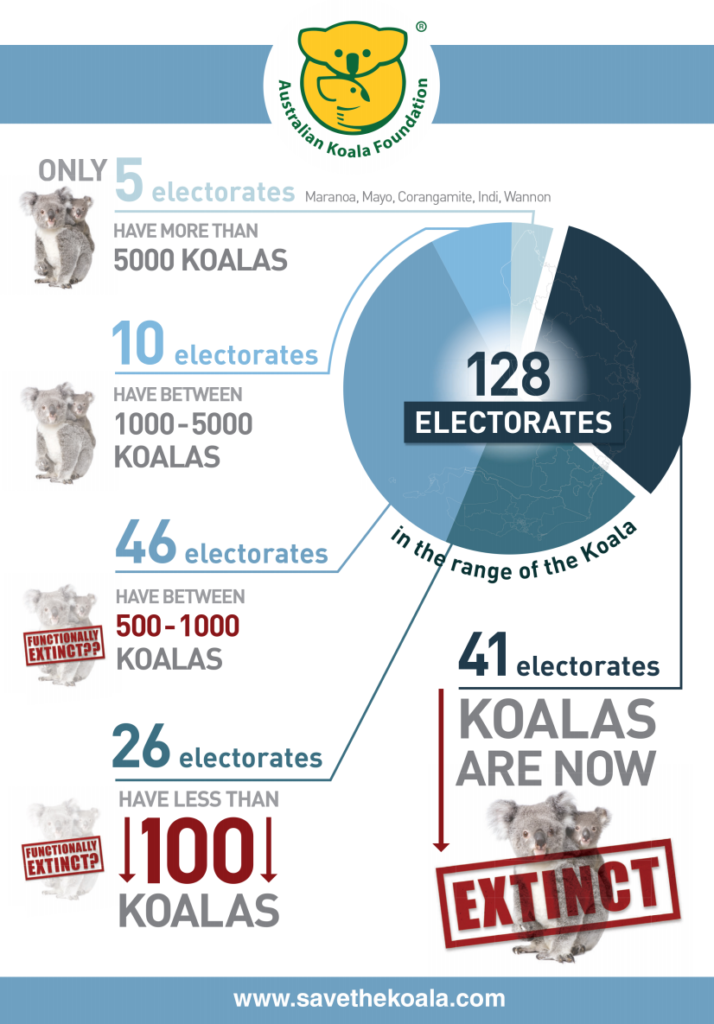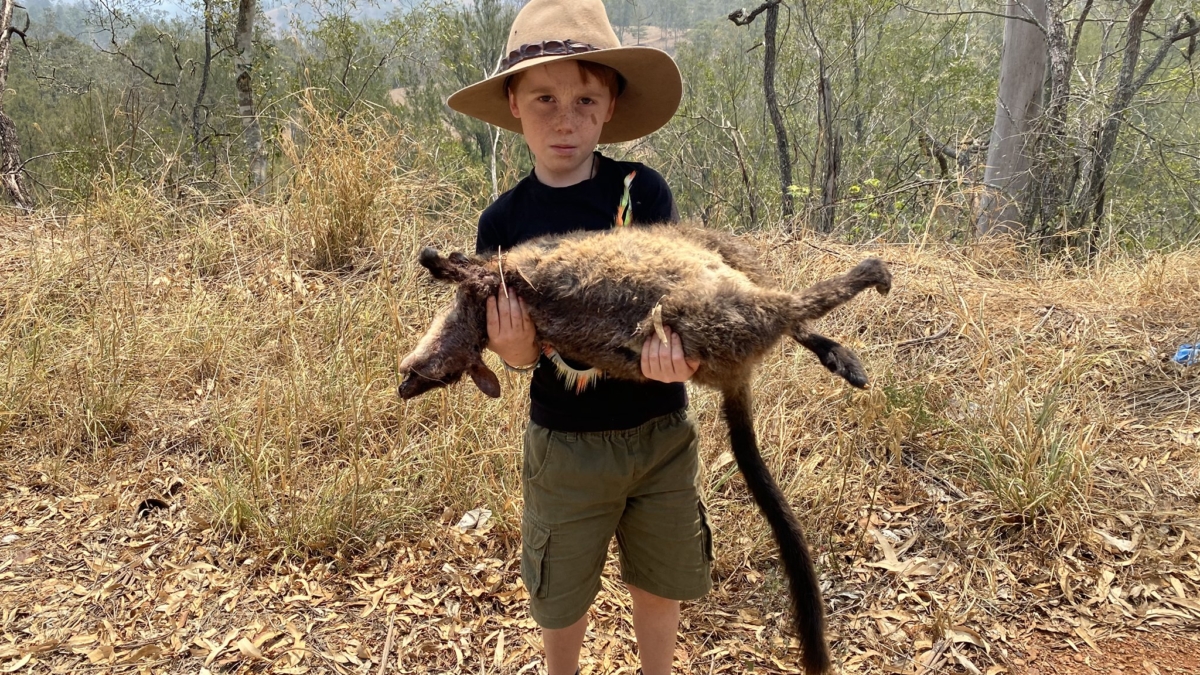Australian Koala Foundation declares koalas “functionally extinct”

By Christine Adams-Hosking
9 May 2019
(The Conversation) – Today the Australian Koala Foundation announced they believe “there are no more than 80,000 koalas in Australia”, making the species “functionally extinct”.
While this number is dramatically lower than the most recent academic estimates, there’s no doubt koala numbers in many places are in steep decline.
It’s hard to say exactly how many koalas are still remaining in Queensland, New South Wales, Victoria, South Australia and the Australian Capital Territory, but they are highly vulnerable to threats including deforestation, disease and the effects of climate change.
Once a koala population falls below a critical point it can no longer produce the next generation, leading to extinction. […]
The estimated percentage of koala population loss in Queensland, New South Wales, Victoria and South Australia was 53%, 26%, 14% and 3%, respectively. The estimated total number of koalas for Australia was 329,000 (within a range of 144,000–605,000), with an estimated average decline of 24% over the past three generations and the next three generations.
The most sickening thing about existing legislation is the fact that industry are given a permit “to take” which is a nicer word for “kill”. All of the other species in those trees don’t even get that permit and die in silence.
Deborah Tabart, Chairman of the AKF
Since May 2012, koalas have been listed as vulnerable in Queensland, New South Wales and the Australian Capital Territory because populations in these regions have declined significantly or are at risk of doing so.
To date, the present “vulnerable” listing has not achieved any known positive results for koala populations in Queensland and New South Wales. In fact, recent research invariably shows the opposite. [more]
A report claims koalas are ‘functionally extinct’ – but what does that mean?

10 May 2019 (Australian Koala Foundation) – The Australian Koala Foundation (AKF) believes Koalas may be functionally extinct in the entire landscape of Australia.
In letters to Prime Minister Morrison and Opposition Leader Bill Shorten, Deborah Tabart OAM, Chairman of the AKF said the Koala’s fate is in their hands. The AKF has received no response.
“The AKF thinks there are no more than 80,000 Koalas in Australia. This is approximately 1% of the 8 million Koalas that were shot for fur and sent to London between 1890 and 1927,” Tabart says.
Since 2010, the AKF has monitored the 128 Federal electorates that fall within the range of the Koala and it is shocking that 41 electorates have no Koalas; they are extinct.
Over 31 years the AKF has worked with 13 Environment Ministers, many which could be described as the ‘Who’s Who’ of the political elite and nothing has happened except dead Koalas in the wild.
Deborah Tabart OAM expresses: “I am calling on the new Prime Minister after the May election to enact the Koala Protection Act (KPA) which has been written and ready to go since 2016. The plight of the Koala now falls on his shoulders.”
“After 31 years I have worked with Ministers Richardson, Kelly, Faulkner, Hill, Kemp, Campbell, Turnbull, Garrett, Burke, Butler, Hunt, Frydenberg, and Price yet no support for the Koalas have been shown. I have heard every excuse under the sun to not step in and protect habitats. It is time they enacted the KPA and create change for our Koalas,” says Tabart.
The Senate Inquiry in 2011 exposed the Koala was in trouble. Since then not enough has been done to protect their habitat. It is the AKF’s view that politicians have abrogated their responsibilities. “While sitting in the Senate Inquiry you could hear industry pleading with the Senators to continue allowing them to have their way with habitats around the country” said Tabart.
Labor had the opportunity to establish a Koala Recovery Plan in 2012 before they lost power to the Coalition in 2013. No one has written anything to protect the Koala in the last six years of Government. A National Recovery Plan, mandated by law, has still not been written. The latest Senate Inquiry into Australia’s Faunal Extinction Crisis has proved that the Environment Protection and Biodiversity Conservation (EPBC) Act is inadequate.
Tabart has written to all sitting members who live in Koala habitat and said that the Koala Protection Act could and must work closely with new proposed environmental laws, promised by Labor and the Greens. What happens if they don’t win? Even if they do, these laws could take years.
“Unlike some of my younger conservation colleagues, I have seen the Koala betrayed before. I have heard many empty promises from members of Government pretending to protect the Koala. Look where we are now. The Koala Protection Act will work and it is ready to go” says Tabart.
The KPA was written to protect not only the Koala but also its trees. Good industry leaders, including farmers, should not be scared of a new approach. Koalas and industry can work together like Koala Beach, the Koala friendly development.
Tabart expresses: “The most sickening thing about existing legislation is the fact that industry are given a permit ‘to take’ which is a nicer word for ‘kill’. All of the other species in those trees don’t even get that permit and die in silence.”
It is time for it to stop and it is time for Australian forests to be protected. The new Australian Government could swiftly put the Koala Protection Act in place. “Both parties say they want to protect the environment. It would be a great way to start by protecting Koala forests which cover 20% of our continent,” says Tabart.
The Koala Protection Act is based on the Bald Eagle Act which works with both the Federal Endangered Species Act and the Environment Protection Authority in the USA. The Bald Eagle Act was successful because there was political motive to ensure their icon did not go extinct. It is time for the Koala to be afforded the same respect.
Tabart says “I know the Australian public are concerned for the safety of
Koalas and are tired of seeing dead Koalas on our roads. It is time for the Government to respect the Koala and protect its habitat.”
Our tourist icon is ready to leave and no, zoos are not the answer. Saving their habitat is.
Find information about the habitats and Koala numbers in each Federal electorate at: www.savethekoala.com/our-work/act-or-axe.
Contact
- Deborah Tabart, OAM 0407 750 668, dtabart@savethekoala.com
Australian Koala Foundation calls on the new Prime Minister to protect the Koala

